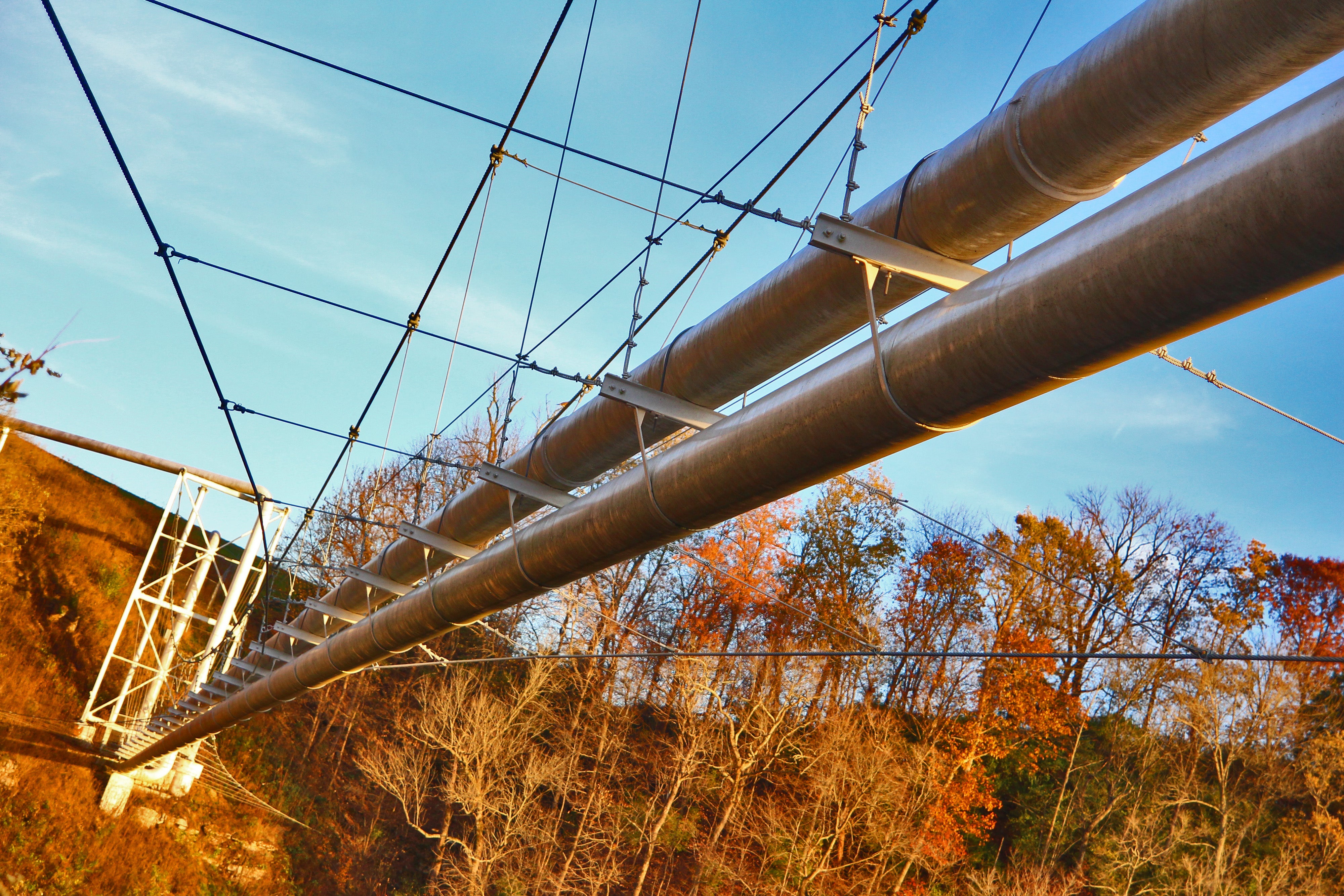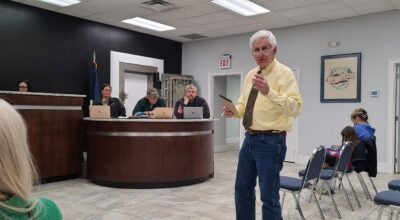Danville-Boyle Chamber among commenters calling for impact study of pipeline plan
Published 9:30 am Friday, November 18, 2016

- Ben Kleppinger/ben.kleppinger@amnews.com The Tennessee Natural Gas pipeline 100-1 crosses Herrington Lake between Boyle and Garrard counties. Energy infrastructure company Kinder Morgan, which owns Tennessee Natural Gas, wants to repurpose the pipeline to carry natural gas liquids from the northeast to the gulf coast.
The Danville-Boyle County Chamber of Commerce and state Sen. Jimmy Higdon are among dozens who have called for an environmental impact study of the Utica Marcellus Texas Pipeline Project since Nov. 2.
As of Thursday, a total of 31 comments had been submitted to the Federal Energy Regulatory Commission concerning the plan from Houston-based energy infrastructure company Kinder Morgan.
All 31 comments call for an environmental impact study of or state outright opposition to the plan, which would repurpose 964 miles of pipeline to send byproducts of fracking called natural gas liquids (NGLs) from the northeast to the gulf coast.
The plan would affect natural gas pipelines in seven states — Ohio, Kentucky, Tennessee, Mississippi, Arkansas, Louisiana and Texas. Of the 31 comments made over the course of about two weeks, 29 have been from Kentucky residents and two have been from people in Cincinnati. Boyle County has produced by far the most comments from any one area, with seven comments coming from Danville, one from Junction City and one from Gravel Switch.
Three residents of Lebanon and Marion County have made comments, as have two residents of Richmond and two in Lexington.
FERC is accepting comments on its environmental assessment through Dec. 2. The assessment states that the plan to stop using the pipeline for natural gas would not have a significant impact on the environment.
According to the assessment, an environmental impact study (EIS) is not necessary, in part because FERC is only assessing the impacts of abandoning the pipeline for natural gas. FERC is declining to consider the potential impacts of piping NGLs, according to the assessment, which reads, “The eventual disposition of the pipeline … is not part of (the) proposed action.”
Chamber’s letter
A letter from the Danville-Boyle County Chamber of Commerce was submitted as a comment on Nov. 14.
“We are writing to seek a rehearing of FERC’s decision that abandoning the pipeline ‘would not constitute a major federal action significantly affecting the quality of the human environment,’” the letter reads. “We strongly disagree and ask FERC to develop a full environmental impact statement (EIS) that includes thorough review of both the environmental effects of the abandonment and the subsequent use of the pipeline for transporting NGLs.”
The chamber argues an EIS should look specifically at the risk posed to groundwater if the pipeline were to leak NGLs.
“When NGLs leak, about 85 percent will turn into an odorless, colorless and highly flammable vapor once they hit the air, settling in valleys, creeks, rivers and other low points,” the letter reads. “Vapors can be ignited by heat, spark or flame, with an explosion potential from a small spark. The other 15 percent of an NGL leak remains a liquid and may contaminate the soil and water with chemicals like benzene, known to be a human carcinogen.”
“With Herrington Lake serving as our primary source of water for our city, county and region, as well as feeding into the Kentucky River, which provides drinking water for Frankfort, Lexington and many other communities and then flowing on into the Ohio River, a large spill in this area has the potential to impact a large portion of the midwest,” the letter continues. “This kind of contamination to our water supply would cause grave economic damage.”
Higdon’s comment
State Sen. Jimmy Higdon, who represents Casey, Marion, Nelson, Spencer and Jefferson counties, commented on Nov. 16, writing that he believes an EIS “is a must.”
“While I am not opposed to pipelines, because that is the safest and most efficient way to move many substances, I do have some serious concerns as to how this particular pipeline could affect our communities in the 14th State Senate District and beyond,” Higdon wrote. “This pipeline in discussion is more than 70 years old and it has a history of known leaks and ruptures. The age and condition of the pipeline bring about not only safety issues but also environmental concerns.”
Other comments
Among other comments, James T. O’Reilly of Cincinnati said he is a professor who has published a textbook, “Administrative Rulemaking,” that addresses in part environmental impact studies. An EIS of Kinder Morgan’s proposal “would find that the effects of the repurposed line will be a dramatic increase in the risk of water and land damage,” O’Reilly wrote.
“Because (FERC) has a duty to seriously consider environmental factors under the Supreme Court’s line of cases since the 1981 Weinberger decision, I urge (FERC) to take the repurposing consequences into account and produce a full EIS,” O’Reilly wrote. “The repurposing is a ‘related action’ with effects that are only possible by virtue of the FERC decision to allow the abandonment. But for the abandonment, the adverse environmental consequences would not result.”
Leah Bayens of Junction City told FERC Kinder Morgan is showing a “lack of regard for the lives an livelihoods” of local residents.
“I can draw the very short line between shoddy physical infrastructure and the realities of physics and biology,” Bayens wrote. “More specifically, I understand that when NGLs containing ethane, butane, hexane, heptane and propane are transported … through antiquated pipes, a breakdown is inevitable at some point. And when that happens along the 120 or so miles of porous karst limestone formations in Kentucky or in the Kentucky River or Herrington Lake, our ground and drinking water will be contaminated for dozens, even hundreds of miles from the point source.”
Rodney Lanham of Gravel Switch said he has farms in Marion County where his family raises beef cattle that depend on groundwater and natural springs.
“A potential leak or rupture would be devastating to our operation in the near but also long term,” Lanham wrote.
“It doesn’t take a mental heavyweight to recognize that there is nothing to be gained by allowing the changes to take place with the exception of financial gain for the private businesses involved,” Alane Miles of Danville wrote. “Please prove wrong those that believe the almighty dollar rules and we are governed by big business for big business by completing an EIS.”
“The impacted pipeline is three miles from my house,” Linda Porter of Danville wrote. “This is the ‘human environment’ in which I, and my neighbors live. … I have studied available literature related to NGLs and firmly believe that it is foolhardy in the extreme to simply replace sections of pipes in a few designated locations, add a few pumping stations and say that all environmental concerns around transport have been met.”
SO YOU KNOW
Anyone who wants to submit a public comment on FERC’s environmental assessment must do so by Dec. 2.
To comment, visit bit.ly/FERC-ecomment and enter your information. When you make your comment, reference docket number “CP15-88-000.”
Comments may also be submitted by mailing letters to Kimberly D. Bose, Secretary, Federal Energy Regulatory Commission, 888 First St. NE, Room 1A, Washington, DC 20426.
FERC staff are available to assist in submitting a comment by calling (202) 502-8258 or by emailing efiling@ferc.gov.






